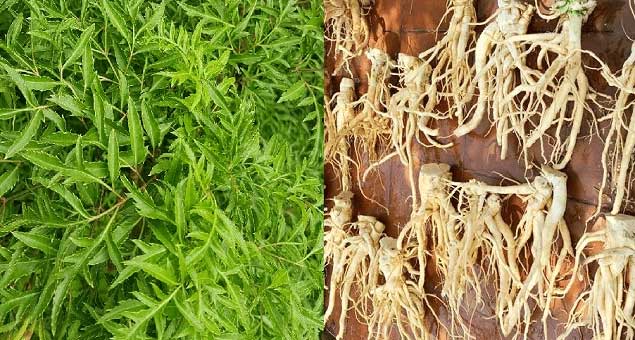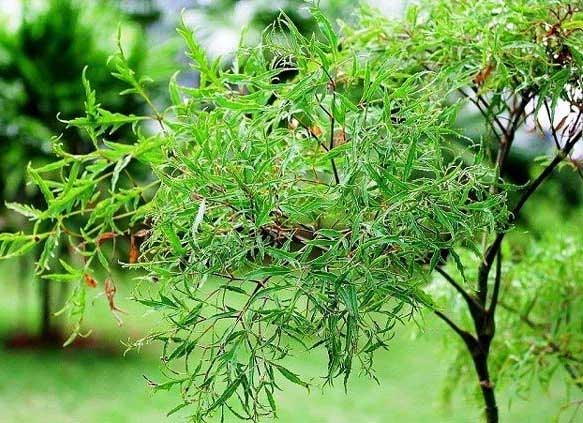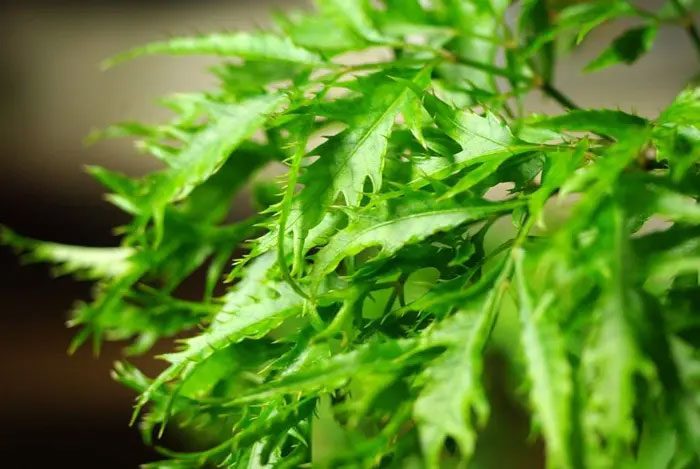Vietnamese ginseng (Đinh lăng) serves as a tonic, energizer, diuretic, kidney enhancer, lactation aid, menstrual regulator, and uterine contraction promoter. It is also used to treat coughs, hemoptysis, and dysentery. This plant is often compared to ginseng due to its medicinal properties.
What is the Vietnamese Ginseng Plant?
The scientific name for Vietnamese ginseng is Polyscias fruticosa (L.) Harms (Panax fruticosum L.), belonging to the Araliaceae family.
There are several types of plants commonly referred to as Vietnamese ginseng, but the one used for medicinal purposes is small-leaved Vietnamese ginseng, also known as fish salad plant. Other similar plants, which are not used for medicinal purposes, include:
- Round-leaved type (Polyscias balfouriana Baill): compound leaves with three small round leaflets and a blunt tip.
- Large-leaved type or sharp-leaved Vietnamese ginseng (Polyscias ilicifolia (Merr.) Baill.): compound leaves with 11-13 small lanceolate leaflets that are deeply serrated.
- Variegated Vietnamese ginseng or silver-edged Vietnamese ginseng (Polyscias guifoylei Baill.).
Parts of the Vietnamese Ginseng Plant Used
Traditionally, the leaves of the Vietnamese ginseng plant are used, but the correct medicinal part is the dried or sun-dried root.
Roots are harvested in the autumn and winter after the plant has been grown for over five years. During this season, the roots are soft and contain many active compounds. The roots are dug up, cleaned, peeled, sliced, and dried in a cool place to preserve their properties. After drying, the twisted roots are typically sliced into thin pieces.

Image of Vietnamese ginseng leaves and roots.
Preparation of Vietnamese Ginseng
Fresh Vietnamese Ginseng: Remove impurities, wash thoroughly, and dry or dehydrate.
Vietnamese Ginseng prepared with ginger and honey: Soak fresh Vietnamese ginseng in 5% ginger liquor, mixing well to absorb the liquor, then stir-fry over low heat. Add honey, mix well to absorb the honey, and then stir-fry until fragrant. Use 5 liters of 5% ginger liquor and 5 kg of honey for 100 kg of medicinal material.
Effects of Vietnamese Ginseng
Effects According to Traditional Medicine
- Vietnamese ginseng is used as a tonic, treating body weakness, poor digestion, and insufficient lactation in women post-delivery, as well as relieving postpartum pain and discomfort.
- It is used to treat coughs, hemoptysis, facilitate urination, and cure dysentery.
- The stem and branches are used to alleviate rheumatism and back pain.
- Leaves are used to treat fevers, boils, and breast swelling.
- The roots of Vietnamese ginseng are used as a tonic to enhance physical strength, treat body weakness, fatigue, and poor digestion, especially in lactating women. In some regions, it is also used to treat coughs, hemoptysis, uterine pain, dysentery, and as a diuretic and detoxifier.
- Leaves can treat fevers, boils, breast swelling, allergic reactions, and wounds (pounded for application). The stem and branches alleviate rheumatism and back pain.
According to Modern Medical Research

Root powder or extract from Vietnamese ginseng can increase the body’s endurance.
According to research from the Vietnam Military Academy, the extract of Vietnamese ginseng has the following effects:
- Increases the amplitude of brain electrical potential, raises the ratio of alpha and beta waves while reducing delta wave activity; enhances the responsiveness of cortical neurons to light stimuli.
- Gently increases arousal during reflex actions in mazes.
- Boosts conditioned reflex activities, including positive and discriminative reflexes.
In general, under the influence of Vietnamese ginseng extract, the cortex is lightly activated and synchronized, improving the functions of the nervous system regarding reception and integration.
When military personnel train in marching exercises, the use of Vietnamese ginseng root powder significantly enhances their endurance and resilience.
Research in Vietnam has shown that root powder or extract from Vietnamese ginseng can enhance human endurance in humid heat conditions, outperforming Vitamin C and herbal teas for cooling. This demonstrates the strengthening effect of this medicinal plant.
Root extracts and powders from Vietnamese ginseng stimulate immunity and enhance resistance to diseases.
Infusions and rice wine made from Vietnamese ginseng leaves inhibit the growth of pus-forming bacteria and intestinal bacteria. Therefore, these preparations are effective against diarrhea, especially in livestock.
What Diseases Does Vietnamese Ginseng Treat?
- Treating fatigue and lethargy: Dried Vietnamese ginseng root, sliced thin (0.50g), add 100ml water, boil for 15 minutes, and divide into 2 or 3 doses throughout the day.
- Facilitating milk flow and relieving breast engorgement: Vietnamese ginseng root (30-40g) boiled with 500ml water until reduced to 250ml. Drink hot for 2-3 days until breast pain subsides and milk flows normally (according to physician Kim Hoán, Practical Medicine, 7 – 1963).
- Treating wounds: Pound fresh Vietnamese ginseng leaves and apply to the wound.
- Treating prolonged fevers, headaches, thirst, cough, chest pain, and yellow urine: Fresh Vietnamese ginseng (30g), lemon peel (10g), tangerine peel (10g), Saigon herb (20g), fresh bamboo leaves (20g), licorice (30g), fresh water morning glory (30g), tamarind (20g). Cut into small pieces, immerse in water, and boil to get 250ml of concentrated decoction, divided into three doses throughout the day.
- Lactation enhancer: Fresh Vietnamese ginseng leaves (50-100g) mixed with one pig’s bladder, chopped, and cooked as porridge.
- Treating uterine pain: Clean and stir-fry Vietnamese ginseng branches and leaves, then brew and drink instead of tea.
- Treating allergic rashes: Vietnamese ginseng leaves (80g), stir-fried, and brewed for drinking. Use for 2-3 months.

The roots of Vietnamese ginseng contain many saponins, which can cause hemolysis.
Precautions and Contraindications When Using Vietnamese Ginseng
Although this medicinal herb is relatively low in toxicity, overuse can lead to poisoning. The most noticeable effects can include congestion in the liver, heart, lungs, stomach, and intestines, as well as nutritional imbalances.
The roots of Vietnamese ginseng contain many saponins, which can cause hemolysis. Therefore, it is advisable to use it only when necessary and in the correct dosage and manner. High doses of Vietnamese ginseng can lead to drug intoxication, resulting in fatigue, nausea, and diarrhea.
Vietnamese ginseng is known for its energizing effects and ability to treat milk stasis. The information provided here is for reference only; it is recommended to consult a healthcare professional before using Vietnamese ginseng.


















































